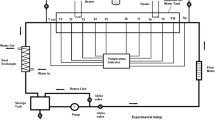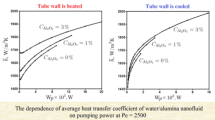Abstract
Analysis of Al2O3/water nanofluid flow in thermally developing region of a circular tube is the subject of present numerical study. In order to consider the hydrodynamically fully developed condition in the tube, a fully developed velocity profile is defined in the inlet section of tube. Three-dimensional computations are performed for a wide variety of nanoparticle concentrations (1 ≤ γ ≤ 10%). On the other hand, for examination of nanoparticle size, effects on the thermal characteristics, two different particle sizes of d p = 25 and 75 nm are applied. The resulting governing equations are solved numerically by means of the finite volume method. For enhanced visualization, different results are presented in thermally developing region. It is obtained that suspending the Al2O3 nanoparticles in pure water increases the thermal boundary layer growing rate. In addition, an increase on the heat transfer rate is observed in thermal boundary layer using the Al2O3 nanoparticles in which this enhancement varies as a function of nanoparticle size and nanoparticle volume concentration. However, it is found that the role of nanoparticle volume concentration on the thermal characteristics such as thermal boundary layer growing rate, temperature gradient, and heat transfer enhancement is significantly important comparing to the nanoparticle size.
Similar content being viewed by others
References
J. Koo and C. Kleinstreuer, “A new thermal conductivity model for nanofluids,” J. Nanopart. Res. 6 (6), 577–588 (2004).
C. T. Nguyen, F. Desgranges, G. Roy, N. Galanis, T. Mare, S. Boucher, and H. Angue Mintsa, “Temperature and particle-size dependent viscosity data for water-based nanofluids—hysteresis phenomenon,” Int. J. Heat Fluid Flow 28 (6), 1492–1506 (2007).
S. M. S. Murdhed, K. C. Leong, and C. Yang, “Investigations of thermal conductivity and viscosity of nanofluids,” Int. J. Therm. Sci. 47 (5), 560–568 (2008).
J. C. Maxwell, A Treatise on Electricity and Magnetism, 2nd ed. (Clarendon, Oxford, 1881), Vol. 1.
S. Lee, S. U.-S. Choi, S. Li, and J. A. Eastman, “Measuring thermal conductivity of fluids containing oxide nanoparticles,” J. Heat Transfer 121 (2), 280–289 (1999). doi 10.1115/1.2825978
S. K. Das, N. Putra, P. Thiesen, and W. Roetzel, “Temperature dependence of thermal conductivity enhancement for nanofluids,” J. Heat Transfer 125 (4), 567–574 (2003). doi 10.1115/1.1571080
R. L. Hamilton and O. K. Crosser, “Thermal conductivity of heterogeneous two component system,” Ind. Eng. Chem. Fundam. 3 (1), 187–191 (1962). doi 10.1021/i160003a005
W. Yu and S. U. S. Choi, “The role of interfacial layers in the enhanced thermal conductivity of nanofluids: a renovated Maxwell model,” J. Nanopart. Res. 5 (1), 167–171 (2003). doi 10.1023/A:1024438603801
W. Yu and S. U. S. Choi, “The role of interfacial layers in the enhanced thermal conductivity of nanofluids: A renovated Hamilton-Crosser model,” J. Nanopart. Res. 5 (4), 355–361 (2004). doi 10.1007/s11051-004-2601-7
Y. Xuan, Q. Li, and W. Hu, “Aggregation structure and thermal conductivity of nanofluids,” AIChE J. 49 (4), 1038–1044 (2003). doi 10.1002/aic.690490420
S. M. Aminossadati and B. Ghasemi, “Conjugate natural convection in an inclined nanofluid-filled enclosure,” Int. J. Numer. Methods Heat Fluid Flow 22 (4), 403–423 (2012). doi 10.1108/09615531211215729
B. Ghasemi and S. M. Aminossadati, “Natural convection heat transfer in an inclined enclosure filled with a water CuO nanofluid,” Numer. Heat Transfer, Part A 55 (8), 807–823 (2009). doi 10.1080/10407780902864623
M. Mahmoodi, “Numerical simulation of free convection of a nanofluid in L-shaped cavities,” Int. J. Therm. Sci. 50 (9), 1731–1740 (2011).
E. Abu-Nada, “Effects of variable viscosity and thermal conductivity of Al2O3/water nanofluid on heat transfer enhancement in natural convection,” Int. J. Heat Fluid Flow 30 (4), 679–690 (2009). doi 10.1016/j.ijheatfluidflow.2009.02.003
R. Mokhtari Moghari, A. Akbarinia, M. Shariat, F. Talebi, and R. Laur, “Two phase mixed convection Al2O3-water nanofluid flow in an annulus,” Int. J. Multiphase Flow 37 (6), 585–595 (2011). doi 10.1016/j.ijmultiphaseflow.2011.03.008
A. A. Abbasian Arani, S. Mazrouei Sebdani, M. Mahmoodi, A. Ardeshiri, and M. Aliakbari, “Numerical study of mixed convection flow in a lid-driven cavity with sinusoidal heating on sidewalls using nanofluid,” Superlattices Microstruct. 51 (6), 893–911 (2012). doi 10.1016/j.spmi.2012.02.015
L. Syam Sundar, N. T. Ravi Kumar, M. T. Naik, and K. V. Sharma, “Effect of full length twisted tape inserts on heat transfer and friction factor enhancement with Fe3O4 magnetic nanofluid inside a plain tube: An experimental study,” Int. J. Heat Mass Transfer 55 (11–12), 2761–2768 (2012). doi 10.1016/j.ijheatmasstransfer.2012.02.040
K. Wongcharee and S. Eiamsa-ard, “Enhancement of heat transfer using CuO/water nanofluid and twisted tape with alternate axis,” Int. Commun. Heat Mass Transfer 38 (6), 742–748 (2011). doi 10.1016/j.icheatmasstransfer. 2011.03.011
D. Lelea, “The performance evaluation of Al2O3/water nanofluid flow and heat transfer in microchannel heat sink,” Int. J. Heat Mass Transfer 54 (17–18), 3891–3899 (2011). doi 10.1016/j.ijheatmasstransfer.2011.04.038
M. Keshavarz Moraveji, M. Darabi, S. M. Hossein Haddad, and R. Davarnejad, “Modeling of convective heat transfer of a nanofluid in the developing region of tube flow with computational fluid dynamics,” Int. Commun. Heat Mass Transfer 38 (9), 1291–1295 (2011). doi 10.1016/j.icheatmasstransfer.2011.06.011
A. A. Abbasian-Arani and J. Amani, “Experimental investigation of diameter effect on heat transfer performance and pressure drop of TiO2-water nanofluid,” Exp. Therm. Fluid Sci. 44, 520–533 (2013). doi 10.1016/j.expthermflusci.2012.08.014
V. Etminan-Farooji, E. Ebrahimnia-Bajestan, H. Niazmand, and S. Wongwises, “Unconfined laminar nanofluid flow and heat transfer around a square cylinder,” Int. J. Heat Mass Transfer 55 (5–6), 1475–1485 (2012). doi 10.1016/j.ijheatmasstransfer.2011.10.030
T. P. Teng, Y. H. Hung, C. S. Jwo, C. C. Chen, and L. Y. Jeng, “Pressure drop of TiO2 nanofluid in circular pipes,” Particuology 9 (5), 486–491 (2011). doi 10.1016/j.partic.2011.05.001
G. Roy, I. Gherasim, F. Nadeau, G. Poitras, and C. T. Nguyen, “Heat transfer performance and hydrodynamic behavior of turbulent nanofluid radial flows,” Int. J. Therm. Sci. 58, 120–129 (2012).
S. M. Peygamberzadeh, S. H. Hashemabadi, M. S. Jamnani, and S. M. Hoseini, “Improving the cooling performance of automobile radiator with Al2O3/water nanofluid,” Appl. Therm. Eng. 31 (10), 1833–1838 (2011).
S. Suresh, K. P. Venkitaraj, P. Selvakumar, and M. Chandrasekar, “Effect of Al2O3-Cu/water hybrid nanofluid in heat transfer,” Exp. Therm. Fluid Sci. 38, 54–60 (2012).
S. Sudarmadji, S. Soeparman, S. Wahyudi, and N. Hamidy, “Effects of cooling process of Al2O3-water nanofluid on convective heat transfer,” FME Trans. 42 (2), 155–160 (2014). doi 10.5937/fmet1402155S
R. Sekhar, K. V. Sharma, R. Thundil Karupparaj, and C. Chiranjeevi, “Heat transfer enhancement with Al2O3 nanofluids and twisted tapes in a pipe for solar thermal applications,” Procedia Eng. 64, 1474–1484 (2013). doi 10.1016/j.proeng.2013.09.229
M. Marzougui, M. Hammami, and R. Ben Maad, “Numerical simulation into the convective heat transfer of Al2O3 and CuO nanofluids flowing through a straight tube using the two phase modeling,” Nanosci. Nanotechnol. 6 (1A), 122–131 (2016). doi 10.5923/c.nn.201601.24
B. Sahin, G. G. Gültekin, E. Manay, and S. Karagoz, “Experimental investigation of heat transfer and pressure drop characteristics of Al2O3-water nanofluid,” Exp. Therm. Fluid Sci. 50, 21–28 (2013).
P. C. Mukesh Kumar, J. Kumar, and S. Suresh, “Experimental investigation on convective heat transfer and friction factor in a helically coiled tube with Al2O3/water nanofluid,” J. Mech. Sci. Technol. 27 (1), 239–245 (2013). doi 10.1007/s12206-012-1206-9
A. Noghrehabadi and R. Pourrajab, “Experimental investigation of forced convective heat transfer enhancement of ?-Al2O3/water nanofluid in a tube,” J. Mech. Sci. Technol. 30 (2), 943–952 (2016). doi 10.1007/s12206-016-0148-z
B. R. Munson, D. F. Young, T. H. Okiishi, and W. W. Huebsch, Fundamentals of Fluid Mechanics (Wiley, New York, 2009).
R. W. Fox, A. T. McDonald, and P. J. Pritchard, Introduction to Fluid Mechanics (Wiley, New York, 2006).
F. P. Incropera, D. P. De Witt, T. L. Bergman, and A. S. Lavine, Fundamentals of Heat and Mass Transfer (Wiley, New York, 2011).
H. C. Brinkman, “The viscosity of concentrated suspension and solution correlations,” J. Chem. Phys. 20 (4), 571–581 (1952).
R. S. Vajjha and D. K. Das, “Experimental determination of thermal conductivity of three nanofluids and development of new correlations,” Int. J. Heat Mass Transfer 52 (21–22), 4675–4682 (2009). doi 10.1016/j.ijheatmasstransfer.2009.06.027
X. Q. Wang and A. S. Mujumdar, “Heat transfer characteristics of nanofluids: a review,” Int. J. Therm. Sci. 46 (1), 1–19 (2007). doi 10.1016/j.ijthermalsci.2006.06.010
www.accuratus.com.
S. V. Patanker, Numerical Heat Transfer and Fluid Flow (Taylor & Francis, New York, 1980).
Author information
Authors and Affiliations
Corresponding author
Additional information
Published in Russian in Teploenergetika.
The article is published in the original.
Rights and permissions
About this article
Cite this article
Hassanzadeh, R., Ozbek, A. & Bilgili, M. Analysis of alumina/water nanofluid in thermally developing region of a circular tube. Therm. Eng. 63, 876–886 (2016). https://doi.org/10.1134/S0040601516120028
Published:
Issue Date:
DOI: https://doi.org/10.1134/S0040601516120028




